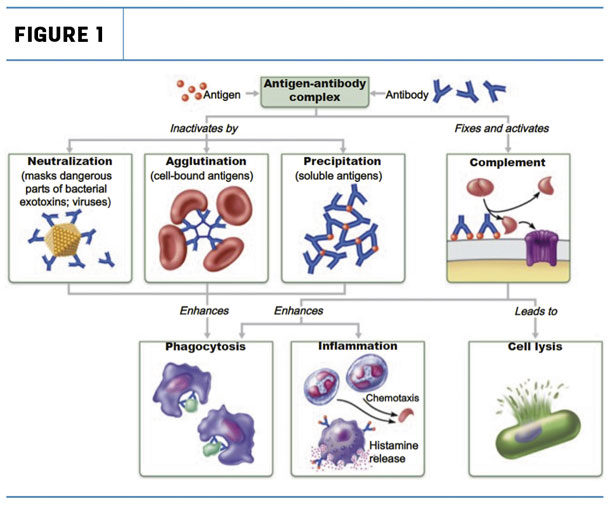The COVID-19 pandemic brought into focus what can happen when a population is exposed to a pathogen – in this case, a virus – that has never been seen by that population before. When the whole population is “naïve,” the virus can quickly spread. One solution to such a problem is to develop a vaccine and thus give people some exposure to the virus in a way they don’t get sick, which then offers protection from the virus if and when they are exposed in the future.
Many questions have arisen about the safety and effectiveness of COVID-19 vaccines. We have a great opportunity to better understand what vaccination programs are meant to do; the types of vaccines on the market and the strengths and weaknesses of each type; how these work to prevent disease; and what constitutes a good and comprehensive vaccination program – for people and livestock.
The immune system: How the body naturally defends against pathogens
When germs, such as bacteria or viruses, invade the body, they attack cells and multiply. This invasion is called an infection and likely makes the person or animal sick. Early signs typically include fever, aches and pains, loss of appetite, and general malaise. Within an animal’s system, its defense mechanisms go to work. The first line of defense is macrophages. These white blood cells recognize the invaders and engulf and digest them. They release digested pieces of the invader back into the bloodstream as antigens.
The second line of defense is B-lymphocytes, another type of white blood cell, which produce specific antibodies to neutralize these antigens. As the invader replicates, the antibody response also goes into high gear. The third line of defense is T-lymphocytes, called memory cells. They multiply and will stay circulating in the system for long periods of time, so the animal can respond more quickly the next time this same invader comes along. When the person or animal has never been exposed to this invader or its antigens before, the infection can overwhelm the immune system and result in severe sickness or even death. It takes the immune system days to weeks to really mount a strong response.
What does a vaccine do?
Think of a vaccine as a primer for the immune response. It gives the person or animal exposure to the invader or pathogen, without actually causing the disease, so the normal immune response can get geared up. This mimics the natural disease process close enough that antibodies and memory cells are activated. Initial response to a vaccine is typically fairly limited, which is why a booster is typically needed. This second shot further energizes the immune system to make more antibodies and memory cells.
This typical two-dose series should then have the immune system primed for an encounter with the actual invader, which we often refer to as the “field strain.” Please understand that vaccines do not always prevent disease, but they will lessen the severity and improve the recovery time if a natural infection does occur. Think of it as one of your risk management tools.

Types of vaccines
Vaccine technology has progressed significantly over the past three decades. In the early years of vaccines, we were limited to killed and modified-live (attenuated) vaccines. As genomic sequencing came of age and we better understand protective coatings of the pathogen, we can now leverage biotechnology to build vaccines where the antigen is no longer the entire virus or bacteria but merely a piece of the protective coating or maybe a binding protein. There are pros and cons to each approach, so let’s dive into a little more detail on each type of vaccine.
Live, attenuated vaccines: These vaccines contain a modified version of the living virus or bacteria that has been weakened so it can’t actually cause disease. It does, however, replicate once in the animal. Because this is the closest thing to a natural infection, the immune response tends to be strong and long lasting. The response to future field strain challenges will be very strong, once the immune system is primed. The concern centers around the weakened strain reverting back to its original form and thus being able to cause the disease. This has historically shown to be a concern that rarely, if ever, happens.
Killed, or inactive vaccines: These vaccines are made by killing or inactivating the virus or bacteria. In this way, they do not replicate in the body. Killed vaccines typically require a higher load of the pathogen, in an attempt to get a similar response. This higher initial dose can come with a stronger initial immune response, where fevers and loss of production are typical complaints. While the antibody response can be big, it tends to be short lived, so booster shots are needed more frequently to maintain protection.
Toxoid vaccines: Some bacteria produce toxins (poisons) once they invade the body. These toxins can be more destructive than the bacteria itself. In this case, the toxins are weakened so they can’t inflict the same damage as the original toxin, allowing the animal’s immune system to prepare to fight the natural toxin, should a future infection take place. Tetanus toxoid would be a good example of this type of vaccine.
Subunit vaccines: Here, scientists take only a part of the virus or bacteria that is critical to the function of the germ. Since only component parts of the original organism are used, there is no replication in the host and side effects or reactions to the vaccine are minimized. An example of this type of vaccine would be the SRP vaccine in livestock for prevention of salmonella. In the SRP case, a purified SRP protein is injected and the body produces SRP antibodies, which bind to receptors on the salmonella organism and prevent the uptake of iron. Without iron, the cell dies, and further replication is limited. The COVID-19 vaccine currently being used is also an example of this type of subunit vaccine. They are very safe and effective (94% to 95%), and this is one of the reasons manufacturers were able to fast-track development and the FDA was willing to give them conditional-use licensing.
Vaccines vary in how they stimulate the immune system, as they differ in the nature of the antigens they contain, both in numbers and characteristics of the antigens. Route of administration and use of adjuvants will also affect the immune response. Adjuvants are carriers or additives to the mix that help determine the type, duration and intensity of the primary response and characteristics of the antigen-specific memory response. This is why some vaccines can be given once or twice when young (e.g., Bangs vaccine in bovine) and never need a booster, while others might require yearly boosters (e.g., flu vaccines in humans). This is more of a problem for attenuated and killed vaccines, as the field strain can mutate and yield the previous vaccine ineffective. This is a real advantage to subunit vaccines, as field strain mutations likely will not get past the subunit antigens from the original strain.
What do I need to do to optimize my farm vaccination program?
- Reduce environmental exposure to pathogens. High numbers of a pathogen can overwhelm a vaccine and result in more disease than expected. Exposure can be reduced with good ventilation, clean, dry bedding and good animal husbandry practices.
- Cows that are on a good plane of nutrition and in a low-stress environment will respond best to vaccines.
- Have appropriate expectations. You are managing risk, but vaccines do not eliminate risk. Animals may still experience mild bouts of disease after being vaccinated.
- Periodically review your vaccination program with your veterinarian. Are you focused on the right pathogens based on your farm history and most recent challenges? Should new vaccines in the market be considered as replacements to previous plans?
- Review the vaccination schedule based on age of the animal and when animals will respond best. Recognize that young animals need repeated doses to build up an adequately primed immune system. Avoid vaccinating young calves and just-fresh cows, as they are unlikely to be able to respond well. Administer booster doses in the timing recommended by the manufacturer.
- Make sure you don’t bunch too many gram-negative vaccines together at one time. A good rule of thumb is no more than two gram-negative products at one time to limit the endotoxin load, which could cause health problems.
- Devise a way to monitor storage temps. Many vaccines are temperature sensitive and can be inactivated by temperature swings prior to use. There are thermometers that show the range of temperatures vaccines have been stored under. Establish a maintenance schedule for your vaccine refrigerator.
- Watch expiration dates. If vaccines expire, throw them away and replace with a fresh supply. You don’t want to trust expired product, even when it’s been stored properly.
—This article first appeared in the Standard Dairy Consultants’ newsletter.
Key takeaways
- Vaccines help develop immunity by imitating a natural infection but without causing illness. Think of them as a “primer” of the immune system.
- A well-designed vaccination program will greatly reduce the risk of large outbreaks but may not totally prevent disease. If problems do occur, cases should be mild and recovery faster.
- There are different types of vaccines, and new technologies continue to advance our vaccine arsenal. Know the pros/cons of each type of vaccine and where they fit best into an overall program.
- Review best practices with your veterinarian to see how your vaccination program stacks up. Where can/should improvements be made?
- COVID-19 vaccines on the market are biotech-derived subunit vaccines. This is the safest type of vaccine, which is why the FDA allowed them to be fast-tracked to conditional-use licenses. Get yourself and your farm crew vaccinated, as these vaccines are safe and highly effective.











